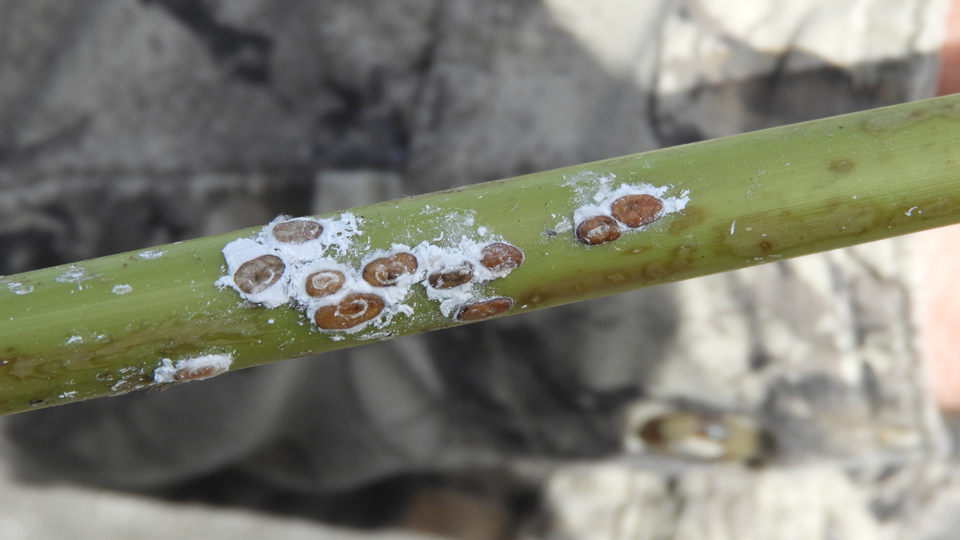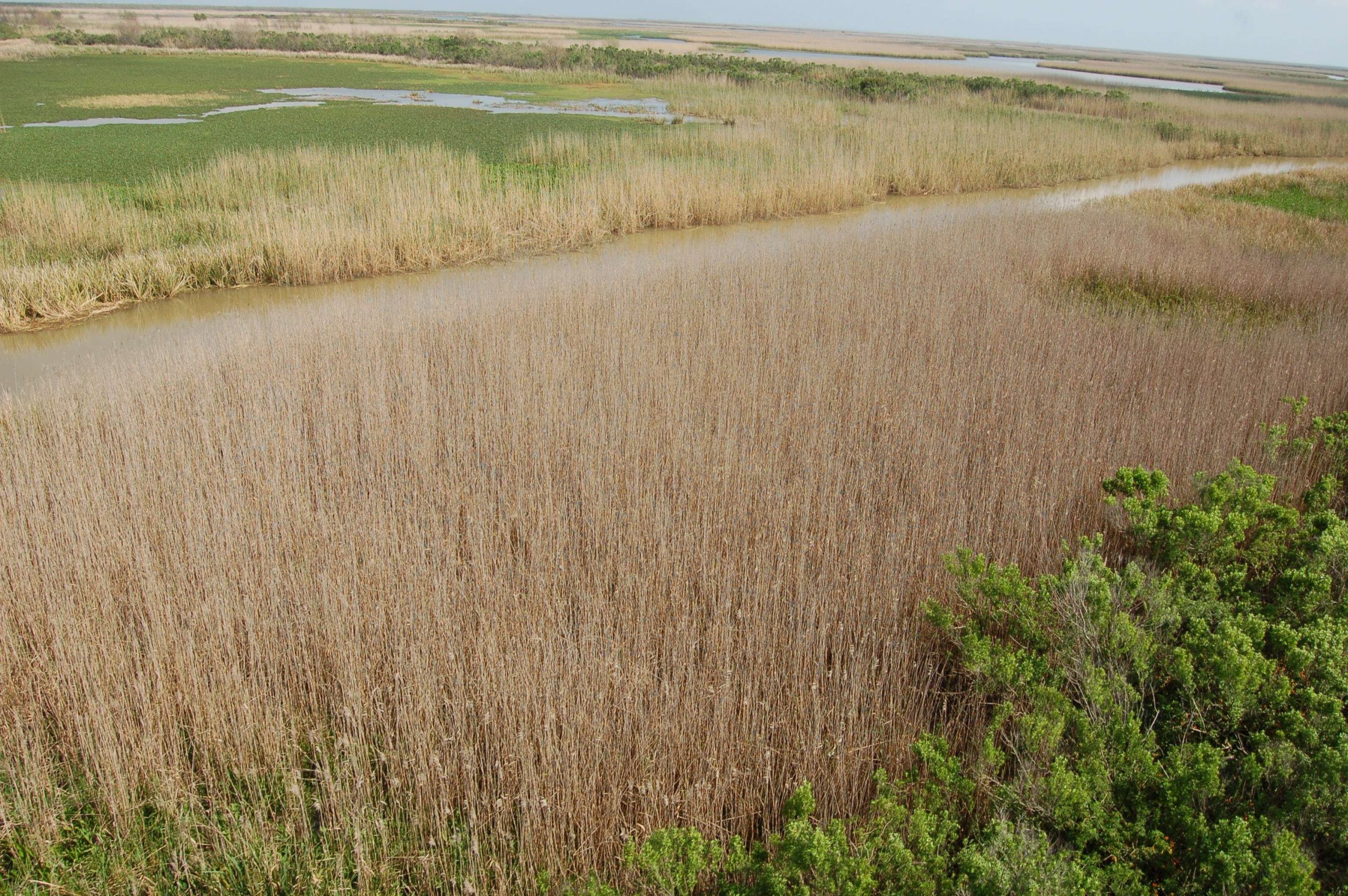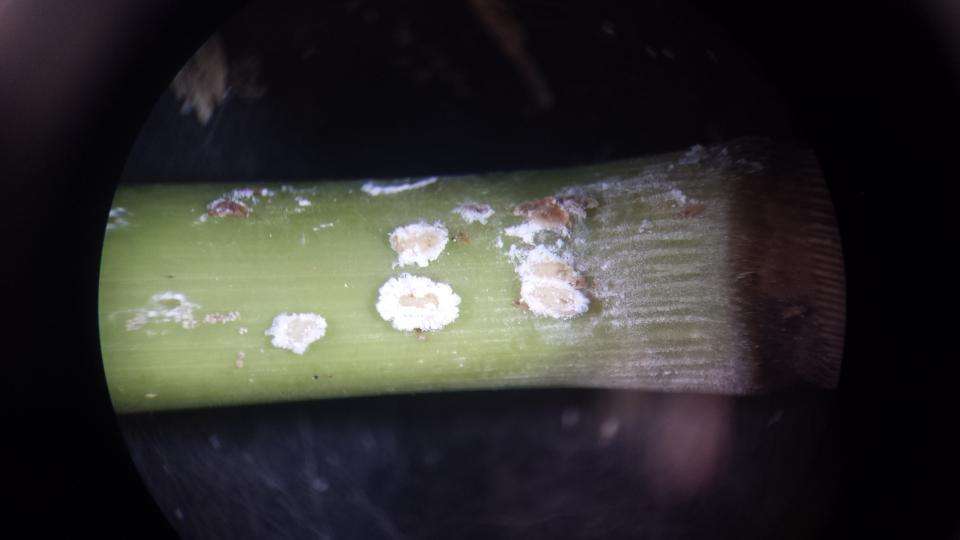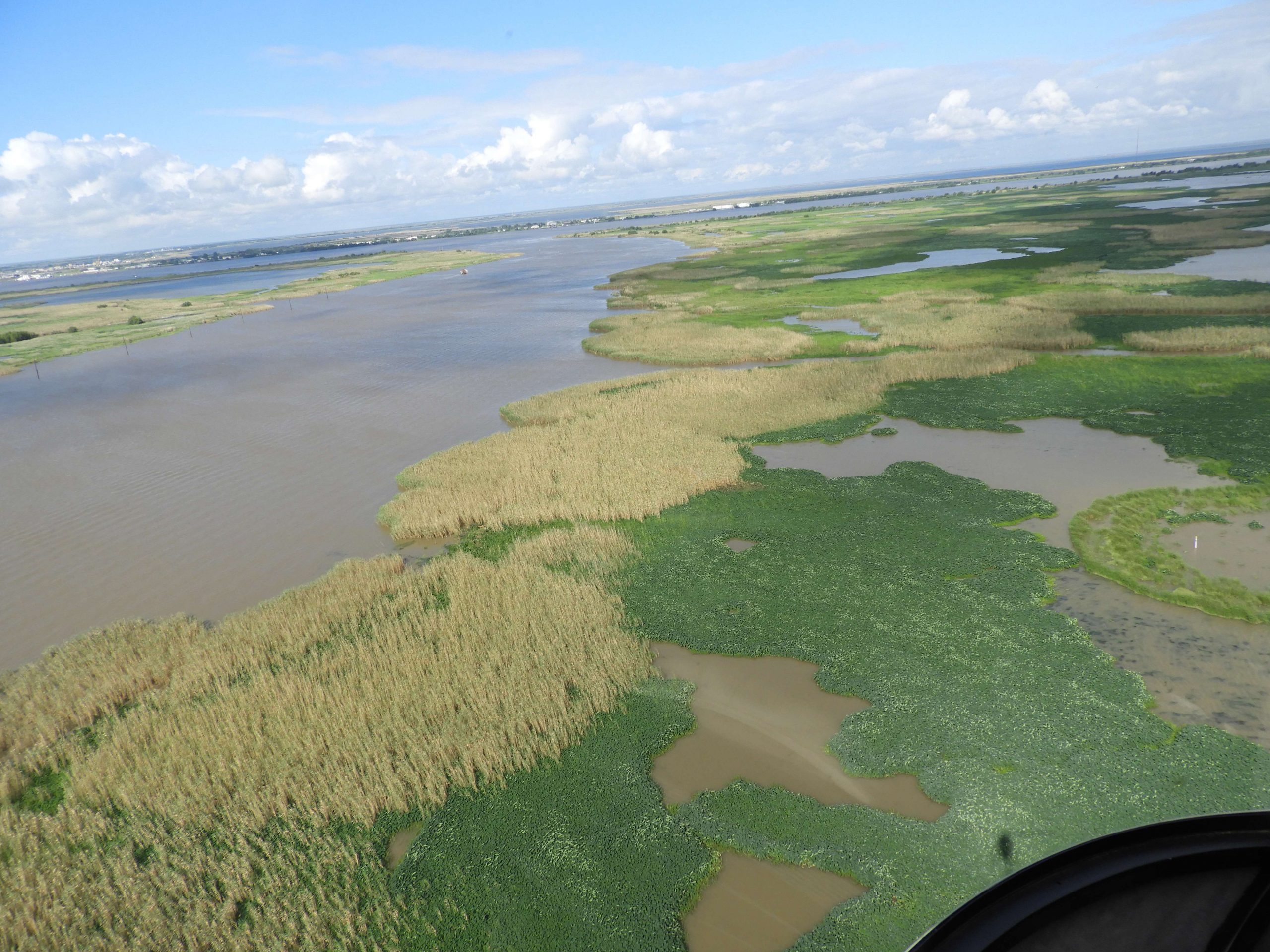
PLAQUEMINES PARISH, Louisiana – The Roseau cane stands guard throughout the Mississippi River Delta. It is a silent sentinel in the vast stretch of untamed mud, grass and water that stretches from the tip of a continent into the Gulf of Mexico.
Each spring, the Roseau rises to heights of 10 feet and taller as it blooms in lusty green groves throughout the marsh. Those stands of Roseau are the bedrock of the delta. They are “nature’s walls” and they protect the marsh (and the people and hard ground behind it) from the punishing push of wind and water that is part of tropical weather here nearly every summer.
The Roseau Cane Mealy Bug, on the other hand, measures about ½-inch long. It is so tiny that it easily carries through the air, as well as on slender blades of grass ferried across the marsh by red-winged blackbirds.
The mighty Roseau plant is no match for the miniscule mealy bug, however, and there are a couple hundred thousand acres of ravaged wetlands throughout southeast Louisiana to prove it.

Biologists aren’t exactly sure when Nipponaclerda biwaskoensis arrived in southeast Louisiana. The tiny bug, also called the Asian scale or the Roseau Cane Mealy Bug, may have been here for years, they said, or it may have only recently arrived from its native China or Japan.
This much is known. When the mild Louisiana winter gave way to the verdant spring earlier this year, large swaths of Roseau didn’t follow suit. Instead, the cane stayed broken, brown, leafless and lifeless. Many longtime biologists and scientists said they had never seen anything like the die-off, and they were caught off guard by a marsh pockmarked with dead cane.
Research quickly found that the scale was munching on thousands of acres of Roseau-rich wetlands. It was near the hallowed fishing villages of Venice and Grand Isle abutting the Gulf of Mexico, and as far west as coastal Vermillion Parish. The insect even was found in the marshes of St. Tammany Parish some 30 miles farther inland than New Orleans.
Scientists from the Louisiana State University AgCenter, the Louisiana Department of Wildlife and Fisheries and more have scoured the delta this summer looking for clues to what is happening on a biological level. Though the jury still is out, some have said it could be that the cane itself is compromised by a variety of factors, including saltwater intrusion, pollutants, and more (though there is no evidence yet to prove that a weakened Roseau has made it more susceptible to the mealy bug’s always-churning jaws). Scientists said it’s possible that the ravenous scale is aggressive enough to level miles and miles of healthy cane, too.
Regardless of the cause, everyone involved agrees it’s imperative that a solution be found soon. They fear for not only the mighty stands of protective Roseau, but for coastal cash crops like sugar cane and sorghum which are biologically similar and theoretically could be in danger.
They also know that less Roseau means more erosion, which is a constant threat to permanently shift the delicate balance of southeast Louisiana’s ecosystem.
Dr. Rodrigo Diaz, an entomologist at LSU AgCenter specializing in invasive species ecology and biological control, said the problem is “very complex.”
“And it’s scary,” he added.

ROOT OF THE PROBLEM
Like the miniscule mealy bug that bears its name, Roseau cane itself is an invasive species in southeast Louisiana. The native plant is found only in Canada and the northern U.S. European Roseau, however, found its way south in the mid-1800s.
Almost immediately, the plant took literal root in the Louisiana marsh and has helped protect and build wetlands since. It’s still doing that all over the state, as large stands of Roseau remain healthy in southeast Louisiana (even in areas that are infested with the mealy bug, which is equally baffling to investigating scientists).
There are four types of Roseau cane found in the Louisiana delta – the European and “Greeny” varieties have been resilient against the mealy bug attacks, while the Delta and Gulf plants have been decimated in the onslaught. By LDWF estimates, some 225,000 acres alone in and around Delta National Wildlife Refuge and Pass a Loutre Wildlife Management Area are at risk. Eighty percent of that acreage, which is located at the far southeast tip of Louisiana, is public land.
Vaughn McDonald, the LDWF Biologist Manager for Coastal Operations, said even in late July, large portions of that marsh bear resemblance to what you’d see in the dead of winter.
“It’s what we call seasonal senescence; when the plants go dormant,” McDonald said. “There are some mud slicks in shallow water. There is open water north of (Delta and Pass a Loutre) in some spots, and the stands of Roseau are thinner too. It’s hard to tell right off the water, but when you do an aerial, you can see the dead spots inside the marsh. It’s like it’s dying from the inside out.”
When the Asian scale is located in Louisiana, LDWF officials plot the spot on a coastal map. To date, the largest concentrations are in Jefferson, Plaquemines, and Lafourche parishes, which form the heart of the Mississippi River Delta. Several inland parishes, connected to the Delta by a matrix of bayous and sloughs, haven’t avoided the infestation either.
McDonald said that’s a problem for Roseau in particular, and for marsh-building restoration projects, in general. Roseau is known for its ability to capture sediment deposited throughout the delta. It is a welcome ally in constructing new marsh as well as protecting present wetlands from erosion, saltwater intrusion, sea rise and subsidence.
All this terrain, of course, is of great importance to the sanctity of one of America’s foremost fisheries – a fact not lost on McDonald.
“When you lose marsh, you get open water,” he said. “That messes with the estuary and the flow of saltwater into the brackish and freshwater areas. It’s not good for bass, or crappie or perch or any other species that needs something other than saltwater to survive.”
Louisiana B.A.S.S. Nation President Kevin Gaubert knows that reality all too well. He said his home waters near Bayou Gauche and Des Allemands southwest of New Orleans have not been effected by the Roseau Cane Mealy Bug, but he’s heard reports from other bass anglers that the legendary cane stands near Venice are compromised.
“We’ve got to figure out what’s going on down there,” he said. “That area is just way too important to fishing.”

DISECT THE INSECT
The Southeast Louisiana Delta indeed is as highly-regarded a fishery as there is in North America. But it’s not the only reason the area is so valued.
Oil and gas production are likely the real lifeblood of these waters today, and the presence of dozens upon dozens of oil and gas wells in the area makes it impossible to deal with the Asian scale much like the Chinese have – by burning affected Roseau to the waterline.
Controlled fire is only one possible solution, that researchers said has been used in other areas of the world battling the mealy bug. Insecticides are potentially another, as are the introduction of parasitic wasps and predatory beetles which would feed upon the invasive scales. Not surprisingly, each option has potential drawbacks, said Gene Gilliland, National Conservation Director for B.A.S.S.
“The options for combating this thing down there are limited, it appears,” Gilliland said. “You can’t set the marsh on fire obviously because of all the oil and gas nearby. You can’t use massive amounts of insecticide (because of harm to fish and birds) throughout the ecosystem.”
Dr. Diaz said it wouldn’t be wise to invest wholesale in a possible solution just yet. Instead, the most likely solution to the Asian scale problem will be found through proper data collection, research and then prudence when it comes to employing strategies to eradicate the insect.
“We know this thing is moving fast, but we’re moving quickly too,” he said. “It would be a waste of taxpayer dollars to dump a whole bunch of insecticide if we don’t know it works….We’re working with the state and following federal guidelines to understand what is happening.”
Diaz admitted that the problem at the mouth of the Mississippi is particularly troublesome, given its remote location. When Roseau cane was dying in Europe a couple decades ago, scientists there found the cane grew stronger if it experienced a prolonged period of dryness.
“We obviously can’t drain the mouth of the river,” Diaz said. “The people in Europe studied the problem for 10 years and they still were undecided on what caused the die-off. They couldn’t pinpoint one thing. So we’re looking at a bunch of different things.”
That includes the fact that two types of Roseau appear to be much more resistant to the mealy bug. That’s promising news, Diaz said.
“We need to work with what Mother Nature is giving us,” he said. “We know two types of the plant are strong. That’s good news. There are possibilities.”
Still, McDonald said having to withstand yet another problem in the Louisiana Delta is an emotional blow. Tropical weather is a constant threat, as are the aforementioned issues of land loss because of sea rise and erosion. He said adding the Roseau Cane Mealy Bug to the mix is a “sucker punch” the Bayou State would rather not endure.
“It’s a push and shove match sometimes,” he said. “Mother Nature pushes and we push back. Sometimes she pushes herself back. We just have to wait and see what the solution is.”
Gilliland said Louisiana doesn’t watch alone.
“The delta is a nationally-renowned fishing destination,” Gilliland said. “We’ve had guys win the Bassmaster Classic down in Venice. So this is not just a problem for people living within 100 miles of there. It’s affecting people across the country, and it’s big news to bass anglers too. You have redfish and trout swimming in the same water as bass there. That’s incredible stuff.
“So you bet we’re paying attention to this. And when they do settle on a solution…we can help with our media reach to get word out across the country and alert people to this situation. We will let them know who to call — their senators and legislators, and all the people who can make a difference in getting this fixed.”





